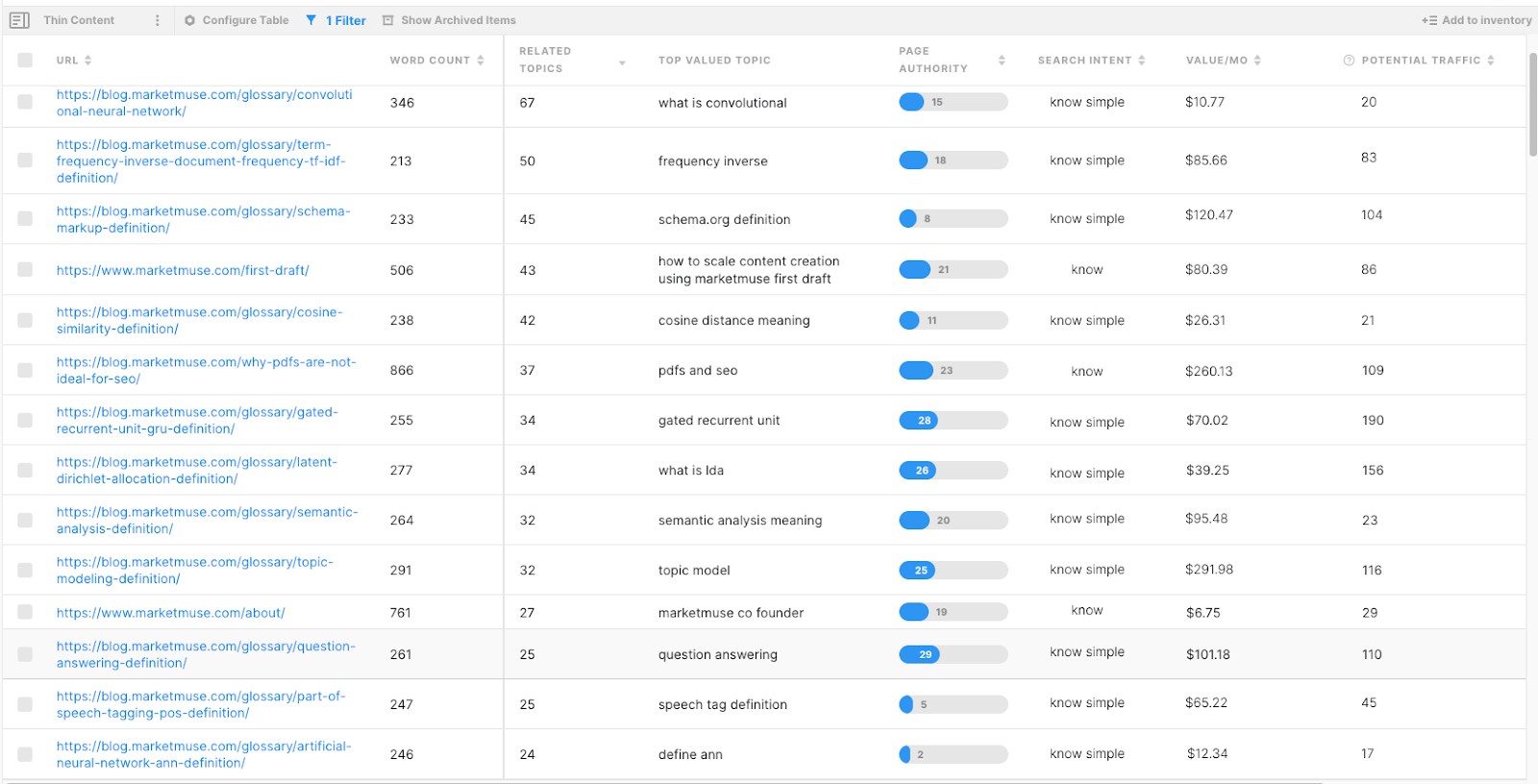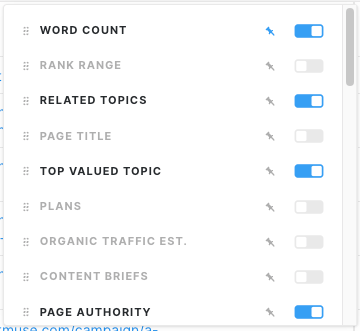Finding and Fixing Thin Content at The Site Level
Some sites suffer from thin content, some don’t. The easiest way to determine which cohort you belong to is by applying the Thin Content Saved View template to your Page Inventory.
Then you can evaluate individual pages with the help of MarketMuse Optimize to determine which ones actually qualify as thin content. Add those pages to a plan for later assignment. Then, use the applications to bring those pages up to a quality standard of which you’ll be proud to re-publish.
Purpose of the Thin Content Page View Template
This Page View Template allows you to quickly isolate pages on your site that are potentially light on information. Along with information about individual pages the generated list provides an indication of the potential impact this can have on your site.

The results need to be taken in context, which this View provides. If our site consists of 306 pages, all of which are potentially thin content, that would give us cause for concern. On the other hand, it’s less of an issue if our site has 30,000 pages.
This View Template contains a filter to show only those pages with less than 1,000 words. Note that there’s nothing magical about this number and you may wish to customize the view, which we talk about later in this article. The goal with the filter is to generate a short list of potential thin content candidates and then work through the list to prioritize those pages that require updating.

Elements of the Thin Content Page View Template
The Thin Content Save View template has nine columns of data, any of which can be sorted by clicking on the top of the column.
URL – In Page Inventory, this data is required as each row in the list contain a unique value.
Word Count – The word count is based on the number of words in the main body with all the boilerplate content (like menus and footers) removed.
Related Topics – This shows the number of related topics for which this page ranks.
Top Valued Topic – The most valuable ranking topic for this page based on our organic traffic estimate times the value-per-visit. This can be helpful in quickly identifying what the page is about, or what it should be about, depending on the situation.
Page Authority – This is a calculation of the overall authority of a page relative to other pages on the same domain. Based on the page’s number of ranking topics and their rank, a page with many well-ranking topics will be more authoritative.

Pages with high authority and little actual content are ranking well as a result of off-page factors and this list will bring those situations to light. These are ideal candidates for The Power Page Plan.
Search Intent – Each page can rank for multiple topics, and each topic can satisfy a different intent. So, in the list view, the most prominent intent is shown from those page/topic intent combinations.
Value/Mo – Expressed as a monthly dollar figure, the value of a page is based on the sum of our organic traffic estimate times the value-per-visit for each topic. This will help you to identify those high-value pages and fix them first.
Potential Traffic – How much traffic you might possibly receive once the page has been improved.
Potential Traffic Gain – The increase in traffic as a result of improving the page. Pay attention to this one – a page may have high potential traffic, but if the actual traffic gain is very little, fixing it shouldn’t be a priority.
Using the Thin Content Page View Template
Here’s a simple workflow you can use to quickly identify if thin content is an issue on your site, what pages to inspect, and what to do with the pages you identify.
Examine the number of potential candidates – The bottom right corner of the Page Inventory list shows the total number of pages found using this filter. Use this to gauge the severity of the issue and set priorities. If you only have a couple of hundred items of possibly thin content on a site with tens of thousands of pages, you’ll most likely move this to the backlog.
Verify the filter is set up appropriately for your site – In our case, we have a lot of definitions which are intentionally concise – 1,000-word manifestos just wouldn’t be appropriate. By adjusting the filter to ignore URLs containing the term “glossary” those entries don’t show up in the list.
Work your way through the list one page at a time – Sort the list by Value/mo descending so that the highest value pages appear at the top of the list. They’re the ones to which you’ll want to pay the most attention.
Run that page in Optimize using the Top Valued Topic – You may need to change the topic if it’s not the correct one. Now check to see where your page’s Content Score rests in relation to the Target Content Score. If your Content Score is substantially below target you’ll want to update the page to bring it more in line with the current environment.
Compare your page’s word count against the Target Word Count to see if you’re in line with what’s typically required to adequately cover the subject of your article. Generally you’re aiming to at least hit the Target Content Score within the Target Word Count. So you may need to update your article if there’s a significant discrepancy.
Add the page to a plan – If the page needs updating, add it to a plan. Create a new plan, if you haven’t done so already, to hold all the pages that you determine need updating due to thin content.
Repeat with the next page in the list – Work your way through the list of thin content candidates, adding them to your plan as required. Make sure to capture both the page and the associated topic. When you’re finished, you can open up the plan and start updating each page using Optimize.
Or assign the task to someone else on your team. Just remember to fill in those particulars, including the due date to ensure nothing slips through the cracks.
This flowchart gives an overview of how the entire process works.

Customizing This Page View Template
In the previous section, you discovered that you might need to customize the template. There are a number of ways you can do this:
Adjusting the filter – You can filter on any of the 30+ data points in Page Inventory. The filter criteria will vary depending on whether the data point is a number or text.

Fun Fact:You can filter on data points without having to display them in the list.
Modifying which columns are displayed – You can change which columns get displayed, except for the URL which is always displayed and pinned to the left.

Changing the order in which columns are displayed – Data columns can be ordered from left to right, depending on your workflow needs. Pinning a column keeps it visible as you scroll from left to right – very convenient in situations where you’re displaying a large number of data columns. You can pin multiple columns if you wish.
Changing the sort column and/or sort order – Page Inventory can be sorted on any column of data that’s displayed.
Takeaway
Applying the Thin Content Saved View to Page Inventory can help you quickly determine if thin content is a problem at the site level. If so, you can use this same view to evaluate these pages and determine whether or not they require updating. Add them to a plan for later processing and use the applications to guide you in updating the content.
What you should do now
When you’re ready… here are 3 ways we can help you publish better content, faster:
- Book time with MarketMuse Schedule a live demo with one of our strategists to see how MarketMuse can help your team reach their content goals.
- If you’d like to learn how to create better content faster, visit our blog. It’s full of resources to help scale content.
- If you know another marketer who’d enjoy reading this page, share it with them via email, LinkedIn, Twitter, or Facebook.
Stephen leads the content strategy blog for MarketMuse, an AI-powered Content Intelligence and Strategy Platform. You can connect with him on social or his personal blog.